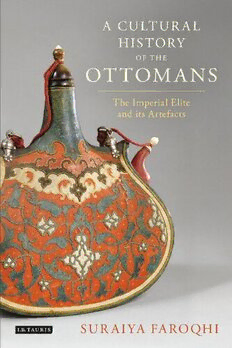Table Of ContentSURAIYA FAROQHI is Professor of History at Istanbul Bilgi University.
She was previously Professor of Ottoman Studies at the Ludwig
Maximilians University, Munich. Among her many publications are
Travel andArtisans inthe Ottoman Empire, Artisans of Empire, The Ottoman
EmpireandtheWorldAroundIt,PilgrimsandSultansandSubjectsoftheSultan
(allpublishedbyI.B.Tauris).
‘Suraiya Faroqhi takes the reader on a journey of discovery: whether in
the shape of a crown, a tent, a rosewater bottle, a pistol, or a coffee cup,
artefacts are here used to narrate a new cultural history of the Ottoman
Empire. With unique erudition and flair, Faroqhi combines bold
interpretationsandintimateandlittle-knownstories.TheOttomanelites,
asifbymagic,becomealive.’
GiorgioRiello,ProfessorofGlobalHistoryandCulture,
UniversityofWarwick
‘EverynewbookbySuraiyaFaroqhiraiseshithertounsuspectedquestions
andpushesourknowledgeintoadifferentsphere.ThisstudyofOttoman
materialculturefromthesixteenthtothemidnineteenthcenturyranges
widelyacrossresearchinarthistory,manufacturing,tradeandconsump-
tion studies. It brings together diverse work on museum collections,
portraits,platesandceramics,onthingsworn,weighedandcultivated,on
itemstakenasbooty,offeredasgiftsorthosesimplytreasured.’
C.M.Woodhead,TeachingFellow(OttomanHistory),
UniversityofDurham
a C u lt u r a l
h iS tory
oF the
o t t o m a n S
the imperial elite
and its artefacts
S u r a i y a
Fa r o q h i
Publishedin2016by
I.B.Tauris&Co.Ltd
London•NewYork
www.ibtauris.com
Copyrightq2016SuraiyaFaroqhi
TherightofSuraiyaFaroqhitobeidentifiedastheauthorofthiswork
hasbeenassertedbytheauthorinaccordancewiththeCopyright,
DesignsandPatentsAct1988.
Allrightsreserved.Exceptforbriefquotationsinareview,thisbook,oranypart
thereof,maynotbereproduced,storedinorintroducedintoaretrievalsystem,
ortransmitted,inanyformorbyanymeans,electronic,mechanical,photocopying,
recordingorotherwise,withoutthepriorwrittenpermissionofthepublisher.
Everyattempthasbeenmadetogainpermissionfortheuseoftheimages
inthisbook.Anyomissionswillberectifiedinfutureeditions.
Referencestowebsiteswerecorrectatthetimeofwriting.
TheauthorisarecipientoftheTurkishCulturalFoundationFellowshipinTurkish
CultureandArt.Thecontentsofthebookarethesoleresponsibilityoftheauthorand
caninnowaybetakentoreflecttheviewsoftheTurkishCulturalFoundation.
ISBN:9781784530969
eISBN:9780857729804
ePDF:9780857727824
AfullCIPrecordforthisbookisavailablefromtheBritishLibrary
AfullCIPrecordisavailablefromtheLibraryofCongress
LibraryofCongressCatalogCardNumber:available
TypesetinStoneSerifbyOKSPrepressServices,Chennai,India
PrintedandboundinGreatBritainbyT.J.International,Padstow,Cornwall
FormyfriendTu¨layArtan
.
)
s
e
i
r
u
t
n
e
c
h
t
n
e
e
t
h
g
i
e
–
h
t
n
e
e
t
n
e
v
e
s
(
e
r
i
p
m
E
n
a
m
o
t
t
O
e
h
t
n
i
s
e
r
t
n
e
c
g
n
i
r
u
t
c
a
f
u
n
a
m
d
e
t
c
e
l
e
S
P
A
M
CONTENTS
Map vi
ListofPlates viii
Acknowledgements xiii
ANoteonTransliteration xvii
Introduction 1
1. Reusingtheworkofpasttimesandforeignlands 34
2. TheOttomansultan:victoriousandpious 60
3. Societyanditsdivisions 81
4. Aworldofthreereligions:Ottomanconquestsandthe
non-Muslimpopulation 99
5. Makingwarandpeace:fighting,gift-givingandthe
delineationofborders 118
6. Eatinganddrinking,mostlyfrompreciousobjects 146
7. Pilesandpilesoftextilesandleathers 166
8. Earth,water,airandfire:thegiftsandperilsofnature 191
Conclusion 215
Glossary 225
Timeline 230
Notes 235
Bibliography 263
Index 303
LIST OF PLATES
Plate 0. A Holbein carpet. Bayerisches Nationalmuseum, Mu¨nchen.
Holbein: Inv.-Nr. T1598, Teppich mit ornamentaler Gestaltung,
Photograph D15440, photographer unknown. Borkopp Restle et al.
(2002). Textile Scha¨tze aus Renaissance und Barock aus den Sammlungen des
BayerischenNationalmuseums:mitgrossenFreuden,TriumphundKo¨stlichkeit,
Ausstellung Mu¨nchen, Bayerisches Nationalmuseum: 10.10.2002–16.2.2003
(Munich:BayerischesNationalmuseum).
Plate1.Romangravestone.AnadoluMedeniyetleriMu¨zesi,Ankara.Author’s
photograph. Credit: French, David (2003). Greek, Latin and Byzantine
Inscriptions of Ancyra (Ankara: The Foundation of Museum of Anatolian
Civilizations),p.146,No.43.
Plate 2. Tile-work panel showing Mecca (seventeenth century). Sadberk
HanımMuseum.SHM-17645kucuk.Bilgi,Hu¨lya(2009).DanceofFire,Iznik
TilesandCeramicsintheSadberkHanımMuseumandO¨merM.Koc(cid:1)Collections
(Istanbul:VehbiKoc(cid:1) Foundation),p.434.
Plate3.Iranianinspirations.MAK.Photograph:qGeraldZugmann/MAK.
T8327. Noever, Peter, ed. (2009). Global-Lab: Kunst als Botschaft, Asien
und Europa/Art as a Message, Asia and Europe (Vienna: MAK), pp. 300–1,
No.227.
Plate4.IndianwarelephantinBelgrade.TopkapıPalaceMuseum.TSMK.
H.1517,fol.98a.Atıl,Esin(1986).Su¨leymanname:TheIllustratedHistoryof
Su¨leymantheMagnificent(Washington,NewYork:NationalGalleryofArt
andHarryN.AbramsInc.),pp.108–9,Ill.No.8.
Plate 5. Chinese porcelain coffee cups. Sadberk Hanım Museum. H.K.
166-3229. Carswell, John (1995). Chinese Ceramics in the Sadberk Hanım
Museum(Istanbul:VehbiKoc(cid:1) FoundationandSadberkHanımMuseum),
p.137,No.190.
LISTOFPLATES ix
Plate6.PistolsfromcentralEuropeintheOttomanEmpire.VesteCoburg.
Source:KunstsammlungenderVesteCoburgV79–80.
Plate 7. Sketches (for a helmet). Bayerisches Nationalmuseum, Mu¨nchen.
Inv.-Nr. 8248, Grafik tu¨rkischer Helm (unvollendet) Photograph D14427
Berlinger. Rapp, Ju¨rgen (2003). ‘Der Pergamentriss zu Su¨leymans Vierkro-
nenhelm und weitere venezianische Goldschmiedeentwu¨rfe fu¨r den
tu¨rkischen Hof aus dem sogenannten Schmuckinventar Herzog Albrechts
vonBayern’,in:Mu¨nchnerJahrbuchderbildendenKunst,3.Series54,105–49.
Plate 8. Portrait of Sultan Mehmed III. Handschrift Rastatt 201, fol. 15b.
Kangal, Selmin et al. (2000). The Sultan’s Portrait: Picturing the House of
Osman(Istanbul:Tu¨rkiyeI˙s¸ Bankası),p.292,No.62.
Plate 9. An Ottoman ambassador in India. The David Collection,
Copenhagen, Inventory number 49/1992, photographer: Pernille
Klemp. Von Folsach, Kjeld (1996). Sultan, Shah and Great Mughal: The
History and Culture of the Islamic World (Copenhagen: The National
Museum),p.411,No.386.
Plate 10. Painting of Mehmed IV. Nordiska Museets, Stockholm.
Picture_0035 Mats Landin, q Nordiska museet. A˚dahl, Karin (2006).
Alay-ı Hu¨mayun: I˙svec(cid:1) Elc(cid:1)isi Ra˚lamb’ın I˙stanbul Ziyareti ve Resimleri 1657–
1658,tr.byAliO¨zdamar(Istanbul:KitapYayınevi),p.79.
Plate 11. A portrait of Mahmud II. Staatsbibliothek Berlin. Cod.or.fol.
3064,Bl.73b/74a.Exhibitioncatalogue(1985).Tu¨rkischeKunstundKultur
ausosmanischerZeit(Recklinghausen:AurelBongers).
Plate12.AyoungOttomangentleman(Levni)andaBursawoman(Levni).
Topkapı Palace Museum. TSMK. H.2164, fol.10b ve fol.7a. I˙repog˘lu, Gu¨l
(1999). Levni: Nakıs¸ S¸iir Renk (Istanbul: Ku¨ltu¨r ve Turizm Bakanlıg˘ı),
pp.180,186,No.7aand10b.
Plate13.Weighingscalesandweights.PeraMuseum.PMA645(scales)and
PMA 241 (weight). Suna ve I˙nan Kırac(cid:1) Vakfı Anadolu Ag˘ırlık ve O¨lc(cid:1)u¨leri
Koleksiyonu. Ku¨rkman, Garo (2003). Anadolu’da Agırlık ve O¨lc(cid:1)u¨leri
(Antalya:AKMED)No.148andNo.185(nopagination).
Plate 14. A peasant family. Staatsbibliothek Mu¨nchen. td33905-00001.
Stackelberg,OttoMagnusFreiherrvon(1831).TrachtenundGebra¨ucheder
Neugriechen(Berlin:Reimer),separateprints.
Plate 15. Faience plate showing a captive. Vo¨lkerkunde-Museum, Munich
(now:Museumderfu¨nfKontinente).Janissaryimage17-33-33@1Ekta-SAM-2.

